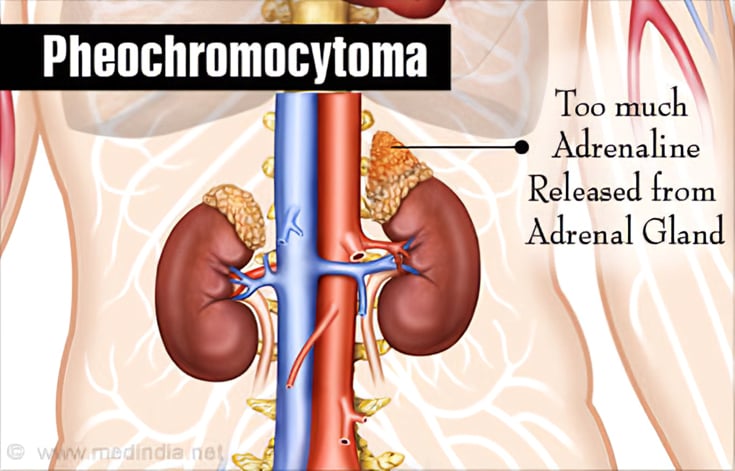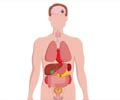- Plouin P, Gimenez-Roqueplo A. Pheochromocytomas and secreting paragangliomas. Orphanet Journal of Rare Diseases 2006, 1:49; doi:10.1186/1750-1172-1-49
- Harrison’s Principles of Internal Medicine 19th edition
What is Pheochromocytoma?
Pheochromocytoma is a rare tumor of the adrenal medulla that secretes substances called catecholamines.
The adrenal glands are a pair of small glands sitting on the top of the kidneys. An adrenal gland is made up of two parts, the outer cortex and the inner medulla. The outer cortex is responsible for secreting various substances like corticosteroids and aldosterone which are of vital importance. The inner medulla also secretes important chemicals called catecholamines. These include adrenaline, noradrenaline and dopamine, which are again of vital importance. Adrenaline and noradrenaline are secreted at times of stress and are responsible for changes in the body that give rise to the ‘fight or flight’ response.
Pheochromocytoma produces excess catecholamines, thereby bringing about several unwanted effects. Pheochromocytomas also appear as a part of the genetic syndromes, neurofibromatosis type 1, von Hippel-Lindau disease (VHL disease) and multiple endocrine neoplasia type 2.
In addition to the adrenal gland, catecholamine-secreting tumors may also sometimes arise from sympathetic nerves at various sites of the body. These are referred to as paragangliomas.

What are the Causes of Pheochromocytoma?
The exact cause of pheochromocytoma is not known, though genetic factors may be responsible. Several genes have been associated with the development of pheochromocytoma. As mentioned above, pheochromocytoma also occurs as a part of certain genetic syndromes.
What are the Symptoms and Signs of Pheochromocytoma?
In several cases, pheochromocytoma does not cause any symptoms and is diagnosed only when the patient undergoes imaging tests for some other condition.
In general, symptoms and signs of pheochromocytoma are because of the high levels of catecholamines and their exaggerated effect on the various body systems. Symptoms appear in bouts as and when excess catecholamines are released into the blood. These episodes may be triggered by change in position, while passing urine etc. Symptoms include:
- High blood pressure; the high blood pressure may not respond to usual medication treatment.
- Bouts of headache, palpitations and excessive sweating
- Digestive tract problems like nausea, pain in abdomen and constipation
- Weakness
- Weight loss
- Features of diabetes like high blood sugar, excessive urination and excessive thirst
- Anxiety with pale skin and panic attacks

The blood pressure can rise high enough to cause stroke, cardiac arrhythmias, blindness and other life-threatening complications.
Features of other genetic conditions may be present. For example, a patient of neurofibromatosis may have swellings along the nerves under the skin and café au lait spots on the skin.
How to Diagnose Pheochromocytoma?
Testing for pheochromocytoma is primarily carried out through blood and urine tests. The levels of catecholamines are increased in the blood and urine of patients with pheochromocytoma. The catecholamines are converted into inactive substances called metanephrine and normetanephrine by enzymes in the body. Therefore, in pheochromocytoma, the level of these inactive substances is also increased, which can be detected in blood and urine tests. Urine tests are conducted on 24-hour sample. The patient is advised to avoid certain drugs like tricyclic antidepressants and acetaminophen 5 days prior to the test since these can interfere with the result.
Blood glucose levels may be altered which can be detected in blood tests.
Imaging tests, which are used in the diagnosis as well as to detect spread of the tumor, are:
- CT scan
- MRI which is a preferred test in pregnant women and in children
- Imaging tests using radioactive substances. These include 123I-MIBG or 131I-MIBG scintigraphy, 111In-somatostatin receptor scintigraphy, 18F-FDG PET, and 18F-DOPA PET

Other tests may be carried out to rule out conditions that are normally associated with pheochromocytoma when it occurs as a part of genetic syndromes.
How do you Treat Pheochromocytoma?
Since the catecholamines bring about their effect by acting on specific sites called alpha and beta receptors, drugs that block their action on these receptors can bring about control of symptoms. Initial treatment should be with an alpha blocker like phenoxybenzamine or prazosin. This should be followed by the addition of a beta blocker like propranolol. Other anti-hypertensive drugs can be used in addition if these drugs are unable to control the blood pressure.
The definitive treatment of pheochromocytoma is through surgery. Before surgery, the blood pressure should be brought under control. Surgery with laparoscopy is preferred to open surgery. Blood pressure can fluctuate during the surgery, and should be closely monitored. Patients should undergo regular follow-ups after the surgery to detect recurrences of the tumor if any.
In addition to surgery, very advanced cases of pheochromocytoma may be administered radiotherapy or chemotherapy.

Prevention of Pheochromocytoma
Since genes play a role in the development of pheochromocytoma, genetic testing to identify individuals at risk could help to diagnose the condition early. This will ensure early treatment before the cancer has spread and a better prognosis for the patient.









